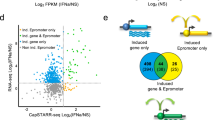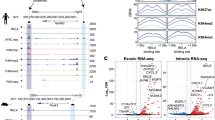Abstract
The proximal promoter region of the gene for the CXCL13/BLC chemokine has been studied by electrophoretic mobility shift assay and reporter gene analysis in order to detect new control elements, in particular, NF-κB binding sites. Two new putative control elements have been identified. One of them contains a Rel/NF-κB binding site and seems to participate in inducible gene expression. The other is an Sp1 factor binding site, essential for basal transcription. It is the first time that such a site is found in the promoter of a target gene of the alternative NF-κB pathway. This finding indicates that genes under the control of the alternative NF-κB pathway can be cooperatively regulated by Rel/NF-κB and Sp1. Our results will add to the understanding of the signaling pathways that govern the expression of genes controlled by the alternative NF-κB pathway.
Similar content being viewed by others
References
Hayden M.S., Ghosh S. 2008. Shared principles in NF-κB signaling. Cell. 132, 344–362.
Bonizzi G., Karin M. 2004. The two NF-kappaB activation pathways and their role in innate and adaptive immunity. Trends Immunol. 25, 280–288.
Hayden M.S., West A.P., Ghosh S. 2006. NF-kappaB and the immune response. Oncogene. 25, 6758–6780.
Gerondakis S., Grumont R., Gugasyan R., Wong L., Isomura I., Ho W., Banerjee A. 2006. Unravelling the complexities of the NF-kappaB signalling pathway using mouse knockout and transgenic models. Oncogene. 25, 6781–6799.
Pasparakis M., Luedde T., Schmidt-Supprian M. 2006. Dissection of the NF-kappaB signalling cascade in transgenic and knockout mice. Cell Death Differ. 13, 861–872.
Dejardin E., Droin N.M., Delhase M., Haas E., Cao Y., Makris C., Li Z.W., Karin M., Ware C.F., Green D.R. 2002. The lymphotoxin-beta receptor induces different patterns of gene expression via two NF-kappaB pathways. Immunity. 17, 525–535.
Ware C.F. 2005. Network communications: Lymphotoxins, LIGHT, and TNF. Annu. Rev. Immunol. 23, 787–819.
Dejardin E. 2006. The alternative NF-kappaB pathway from biochemistry to biology: Pitfalls and promises for future drug development. Biochem. Pharmacol. 72, 1161–1179.
Natoli G., De Santa F. 2006. Shaping alternative NF-κB-dependent gene expression programs: New clues to specificity. Cell Death Differ. 13, 693–696.
Ansel K.M., Ngo V.N., Hyman P.L., Luther S.A., Forster R., Sedgwick J.D., Browning J.L., Lipp M., Cyster J.G. 2000. A chemokine-driven positive feedback loop organizes lymphoid follicles. Nature. 406, 309–314.
Finke D., Acha-Orbea H., Mattis A., Lipp M., Kraehenbuhl J. 2002. CD4+ CD3- cells induce Peyer’s patch development: role of alpha4beta1 integrin activation by CXCR5. Immunity. 17, 363–373.
Forster R., Mattis A.E., Kremmer E., Wolf E., Brem G., Lipp M. 1996. A putative chemokine receptor, BLR1, directs B cell migration to defined lymphoid organs and specific anatomic compartments of the spleen. Cell. 87, 1037–1047.
Luther S.A., Ansel K.M., Cyster J.G. 2003. Overlapping roles of CXCL13, interleukin 7 receptor alpha, and CCR7 ligands in lymph node development. J. Exp. Med. 197, 1191–1198.
Coope H.J., Atkinson P.G., Huhse B., Belich M., Janzen J., Holman M.J., Klaus G.G., Johnston L.H., Ley S.C. 2002. CD40 regulates the processing of NFkappaB2 p100 to p52. EMBO J. 21, 5375–5385.
Siebenlist U., Brown K., Claudio E. 2005. Control of lymphocyte development by nuclear factor-kappaB. Nature Rev. Immunol. 5, 435–445.
Weih F., Caamano J. 2003. Regulation of secondary lymphoid organ development by the nuclear factor-kappaB signal transduction pathway. Immunol. Rev. 195, 91–105.
Bonizzi G., Bebien M., Otero D.C., Johnson-Vroom K.E., Cao Y., Vu D., Jegga A.G., Aronow B.J., Ghosh G., Rickert R.C., Karin M. 2004. Activation of IKKalpha target genes depends on recognition of specific kappaB binding sites by RelB:p52 dimers. EMBO J. 23, 4202–4210.
Britanova L.V., Makeev V.J., Kuprash D.V. 2008. In vitro selection of optimal RelB/p52 DNA-binding motifs. Biochem. Biophys. Res. Commun. 365, 583–588.
Dynan W.S., Tjian R. 1983. The promoter-specific transcription factor Sp1 binds to upstream sequences in the SV40 early promoter. Cell. 35, 79–87.
Marin M., Karis A., Visser P., Grosveld F., Philipsen S. 1997. Transcription factor Sp1 is essential for early embryonic development but dispensable for cell growth and differentiation. Cell. 89, 619–628.
Bouwman P., Philipsen S. 2002. Regulation of the activity of Sp1-related transcription factors. Mol. Cell. Endocrinol. 195, 27–38.
Suske G., Bruford E., Philipsen S. 2005. Mammalian SP/KLF transcription factors: bring in the family. Genomics. 85, 551–556.
Zhao C., Meng A. 2005. Sp1-like transcription factors are regulators of embryonic development in vertebrates. Dev. Growth Differ. 47, 201–211.
Yao P.L., Lin Y.C., Sawhney P., Richburg J.H. 2007. Transcriptional regulation of FasL expression and participation of sTNF-alpha in response to Sertoli cell injury. J. Biol. Chem. 282, 5420–5431.
Zhu N.L., Li C., Huang H.H., Sebald M., Londhe V.A., Heisterkamp N., Warburton D., Bellusci S., Minoo P. 2007. TNF-alpha represses transcription of human Bone Morphogenetic Protein-4 in lung epithelial cells. Gene. 393, 70–80.
Yan Y., Dalmasso G., Sitaraman S., Merlin D. 2007. Characterization of the human intestinal CD98 promoter and its regulation by interferon-gamma. Am. J. Physiol. Gastrointest. Liver Physiol. 292, G535–G545.
Baetu T.M., Kwon H., Sharma S., Grandvaux N., Hiscott J. 2001. Disruption of NF-kappaB signaling reveals a novel role for NF-kappaB in the regulation of TNF-related apoptosis-inducing ligand expression. J. Immunol. 167, 3164–3173.
Xu J., Zhou J.Y., Wu G.S. 2006. Tumor necrosis factor-related apoptosis-inducing ligand is required for tumor necrosis factor alpha-mediated sensitization of human breast cancer cells to chemotherapy. Cancer Res. 66, 10092–10099.
Tone Y., Kojima Y., Furuuchi K., Brady M., Yashiro-Ohtani Y., Tykocinski M.L., Tone M. 2007. OX40 gene expression is up-regulated by chromatin remodeling in its promoter region containing Sp1/Sp3, YY1, and NFkappa B binding sites. J. Immunol. 179, 1760–1767.
Xu Y., Fang F., Dhar S.K., St Clair W.H., Kasarskis E.J., St Clair D.K. 2007. The role of a single-stranded nucleotide loop in transcriptional regulation of the human sod2 gene. J. Biol. Chem. 282, 15981–15994.
Shi Q., Le X., Abbruzzese J.L., Peng Z., Qian C.N., Tang H., Xiong Q., Wang B., Li X.C., Xie K. 2001. Constitutive Sp1 activity is essential for differential constitutive expression of vascular endothelial growth factor in human pancreatic adenocarcinoma. Cancer Res. 61, 4143–4154.
Author information
Authors and Affiliations
Corresponding author
Additional information
Original Russian Text © L.V. Britanova, D.V. Kuprash, 2009, published in Molekulyarnaya Biologiya, 2009, Vol. 43, No. 4, pp. 657–665.
Rights and permissions
About this article
Cite this article
Britanova, L.V., Kuprash, D.V. New putative control elements in the promoter of the gene for the CXCL13 chemokine, a target of the alternative NF-κB pathway. Mol Biol 43, 604–611 (2009). https://doi.org/10.1134/S0026893309040128
Received:
Accepted:
Published:
Issue Date:
DOI: https://doi.org/10.1134/S0026893309040128




